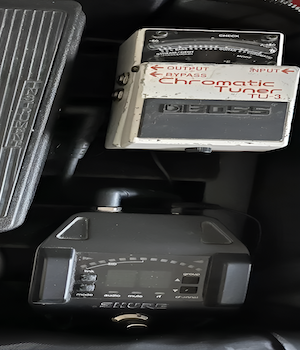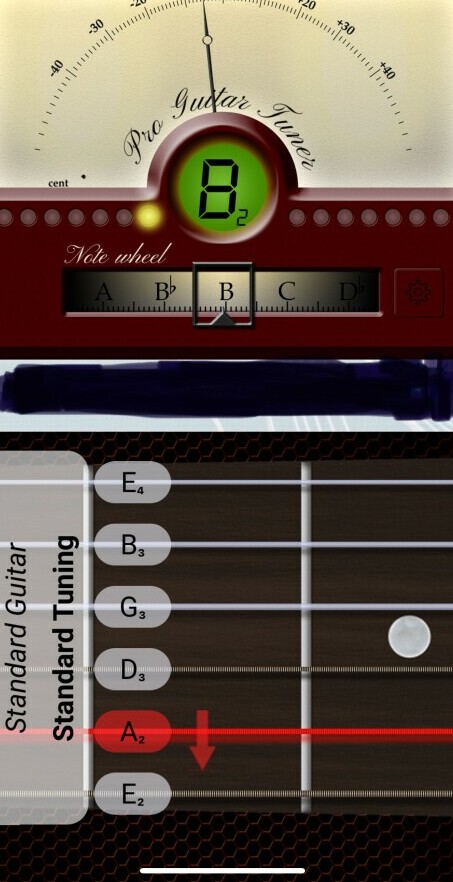
Tuning is the foundation of good guitar playing. Without proper tuning, even the best technique won’t sound right. Beginners, tuning your guitar should be the first thing you do when getting ready to play.
There’s nothing worse to the ears than an out-of-tune guitar. How to tune a guitar for beginners? Well, when it comes to tuning, you’ve got a few choices.
You can use electronic devices that make the process straightforward or go old school and use a tuning fork.
I had one.

You want to start off on the right foot. Starting with the standard tuning at (440hz) is your home base, the center of the tuning universe for most music you’ll be playing.

Here‘s my well-worn out Boss tuner next to my Shure wireless pedal and Dunlop Crybaby (Hendrix fanatic)! The tuning pedal should always be the first in the chain on a musician’s pedalboard to ensure pitch accuracy.
Remember, always be in tune!
There are tuners you can clip right onto your headstock, sleek tuning pedals for the stage performer (see above pic), even classic tuning forks if you’re feeling a bit RETRO.
Meanwhile, tuning apps are an alternative that let you take advantage of the technology right in your pocket. Check your favorite app store for an easy guitar tuning solution.

Now let’s get into practical steps of how to tune your guitar string by string. Start tuning from the thickest string (low E) to the thinnest string (high E). Strings are tuned in this order: E, A, D, G, B, E
Each turn of the tuning peg should be made with care, bringing each string to its perfect pitch. It’s a process, but hey, it’s a process worth mastering, and it’ll be music to your ears.
Consistently keeping your guitar in tune will do wonders for your playing. Not only will your music sound better, but it’ll also train your ears.
You’ll start to naturally know when a string is out of whack, which is an essential skill for any musician. For more tips on becoming a better musician, read the complete beginner rock guitar guide.
Sometimes, things go a bit sideways, and your guitar just won’t stay in tune. Chill out, it happens to the best of us. There can be several reasons, from new strings stretching out, to a change in the weather affecting the wood of your guitar.
Understanding The Fretboard And Guitar Strings is another insightful article that’ll help you understand more about the fundamentals.
This is what I do EVERY time I change my strings:
Doing this will effectively stretch your strings out and, after a few times, they will stay in tune.
Make it a habit to check your tuning each time before playing because you want to continuously train your ears for certain pitches. You’ll be a pro in no time, I promise.
There will come a time when you start jamming with your friends. Playing music with other guitarists will help you grow as a musician. First, make sure at least one of the other instruments is tuned properly and then you can tune your guitar by ear.
In this tuning method, I’ve always found it easier to start with the lower strings like the low E, A, or D. Again, this is where training your ears to distinguish the different pitches will help you.
When tuning to another instrument where you adjust the pitch of your strings up or down to match their pitch, this is called relative pitch. Same with matching up with the notes from your favorite songs.

One thing you’ll notice when trying to learn your favorite tunes is that the tunings will be much different than standard tuning.
Once you’ve got the basics of tuning your guitar to the standard 440hz down, you’re going to find out about a whole new world of possibilities that alternate tunings offer.
You will soon discover that the musicians you idolize will sometimes adjust their tuning to fit a vocalist’s range. There’s also a classic technique called “varispeed” where producers would slow down or speed up the tape during recording sessions. Even in the digital age, this technique endures.
Sometimes guitarists changed their tunings to get a darker ‘edgier’ sound, or just because it sounds waaaay cooler! If it fits the vibe you’re aiming for, the sky’s the limit man!
And let me tell you, it’s a game-changer. Alternate tunings not only provide a breadth of new tonal landscapes but also inspire creativity and can make playing certain songs or styles much easier.
If you’re feeling adventurous, you can safely detune your guitar a half-step, full-step, and even further.
It’s thrilling to play around with tunings because it provides fresh ideas that you normally wouldn’t expect. It kind of rewires your brain to think outside of the box.
You also have the intriguing options of open tunings, which are often used in blues and folk music, and Nashville tuning, which uses higher octaves for a jangly, bright sound.
Try these tunings if you get a little curious. Strings from Low-High.
Start with standard tuning to perfect the basics. Once you’re ready, explore alternate tunings to unleash creative potential.
A critical part of advancing in your guitar playing is training your ear. As you get more comfortable with your instrument, you’ll start to instantly know if something doesn’t sound right.
Whether you’re strumming a chord or plucking a single string, being in tune is always important. Plus, pitch accuracy is going to be your best friend in sessions or when playing alongside other musicians.
Now, as for the odd and custom tunings – that’s where you can really let your imagination run wild. These tunings can completely transform the mood or vibe of a piece of music. But remember, there’s no rush. Experimenting with these should come after you’re confident with the fundamentals.
For this post, we‘re staying with the standard tuning. After mastering this, we will dive deeper into all of these alternative tunings that you can experiment with. So stick with me.
I really hope that you embrace the joy of tuning as a pivotal part of your guitar journey. Changing tunings can be a fun experience, so mix it up and keep your ears sharp. Who knows what incredible music you’ll create once you start exploring all the tunings your guitar can offer!
Still looking for a cheap beginner electric guitar? Check these out;
Also, take a look at Guitar Gear for great deals on entry-level guitars, straps, and picks.

I’ve been playing guitar 40 years now; writing, recording, and rocking in bands. Randy Rhoads, Warren DiMartini, and of course, Jimi Hendrix all lit the fire for me, and I’ve been chasing that passion ever since.